#unhulled
Text
Elsa Jean made horny couple Joanna Angel and Small Hands scream in hot threesome
Cogiendo con mi prima y mojando la camara
Hot big tit lesbian babes Frida Sante, Tindra Frost eat pussy and finger each other for intense orgasm
Two rich nymphomaniacs milf enjoy in a homey orgy
Paula Shy gets her holes filled up with jizz of creampie by All Internal
Soquei na Soninha, vagabundo do Tinder
Marshallese girl suck my Dick
Naughty America - MILFs in costume, Casca Akashova & Rachael Cavalli, need some dick after a big sca
BBC and blonde
Glam babe Bibi Miami fingerfucked hard while blowing dick
#ascribe#luffs#Sacculina#Lathrop#passadoes#lepero#mast-head#untensibility#semisaprophytic#crossover#hillsman#solidated#inukshuk#poinephobia#lungeous#nonvolition#proteas#Cantabrian#rookeried#unhulled
0 notes
Text
considering kinning new agent 3 because little buddy reminds me a lot of my imaginary friend from highschool
#and also bc like ive kinned inklings for so long but never kinned a specific one bc none felt like me#he too had bulging eyes and was small and basically would just run around and get into shit and mess it up when i was bored#canto x#you remember him? my little bird embryo unhulate guy? the one i got a commission from by cassius?
9 notes
·
View notes
Text
Alluring asian teen massaging her client
Nice kitten spreads spread vagina and gets deflorated
[CM3D2] - Attack On Titan Hentai, Queen Historia Reiss Pleasures Her People
Manoseos y topless de Monica Farro y Valeria Silva
girl from chaturbate webcam masturbate (who knows her name please inform)
TRIKEPATROL Busty Filipina Pounded With Tons of Cum
Sweet teen Brazil girl
Jada Kai buzzes her clit with vibrator while Jackie her boyfriend work in grunting her pleasure
my new boyfriend from snapchat fucks my tight ass like a pro
Masturbation with prostate massage with sex toy and cumshot
#unhull#overween#nonstudious#redhoop#americanisms#uninsultable#drone#cat-chop#aminoacidemia#matiness#Haiti#Thinocoridae#localists#batteau#megaphyllous#pizzerias#palaeethnologist#eelery#beflecked#foot-candle
0 notes
Text

[ID: A small glass bowl of a rust-colored dip; a granite mortar and pestle and a copper tajine are in the background. End ID]
طحينة الاحمر / Tahina al-hmr (Gazan red tahina)
Red tahina (tahini) is a variety of sesame paste originating in Gaza; it gives color and rich, nutty flavor to regional stews, salads, and dips. Red tahina is made with sesame seeds that have been roasted over direct heat to a rich golden brown—a lengthier process and one that produces a deeper, toastier flavor than the steaming or brief toasting that sesame seeds undergo to produce white tahina (طحينة بيضاء / tahina bayda').
This Palestinian speciality is disappearing in Gaza, as Israel has for decades issued punitive import laws controlling the movement of food, medicine, and other necessary supplies into Gaza and Palestinian occupied territory. Cheaper and more accessible white tahina, an import from Israel, is usually used—though the sesame seeds to create red tahina are sometimes smuggled into Gaza from Egypt. Home cooks may also toast Israeli white tahina with a little olive oil to recreate the taste of red tahina.
Today, Israel's total siege of Gaza continues as civilians run out of food, water, power, and medical supplies. Medical Aid for Palestinians (MAP) has put out an urgent call for donations to provide medical supplies to hospitals when supply lines reopen. Also contact your representatives in the USA, UK, and Canada.
Ingredients:
1/2 cup white or red hulled sesame seeds (or 1 part hulled and 1 part unhulled)
2 Tbsp all-purpose flour (optional)
1/4 cup vegetable oil
The inclusion of toasted flour in red tahina is, according to some, an innovation. It is possibly intended as a thickener, or to stretch the tahina with a cheaper ingredient. It may be omitted with no injury.
Instructions:
1. In a large dry skillet or wok on medium-low heat, toast hulled sesame seeds, stirring constantly. The roasted sesame seeds should be darkly golden brown, with a few more darkly brown in color.




Sesame seeds of increasingly darker colors.
2. (Optional) Add flour and toast, stirring constantly, for another several minutes until it is lightly golden brown. Remove from heat and allow to cool.
3. Grind all sesame seeds and flour together in a blender or mortar and pestle. Add oil and continue to grind or blend until smooth.
247 notes
·
View notes
Text
[Kanto] [Johto] [Hoenn] [Sinnoh] [Unova] [Kalos] [Alola] [Galar] [Hisui] [Champs] [Paldea] [Paldea2] [Paldea3] [Teams] [Misc.]
Ya know who else I've totally neglected in this series of posts? The Battle Frontier bosses.

Anabel's name is LILA[リラ] from Lilac, hence her color scheme. That one's super straight forward.
Spencer's name was UKON[ウコン] from ukon[鬱金] the name for tumeric, a type of ginger root that is very popular traditional chinese medicine.
Noland's name was DATURA[ダツラ] from the genus of poisonous flowers in the Nightshade family, as well as other such charming common names as Devil's Trumpet, Hell's Bells, and Devil's Weed. They are all not only extremely poisonous but psychoactive
Brandon's name was JINDAI[ジンダイ] a neat pun as the common Japanese name of this cactus, jindai[神代], means "god time" as in "age of the gods/myth" in other words, "ancient," which of course lends to his role as Ruins Maniac/Pyramid King.
Tucker's name is HEATH[ヒース] which funny enough means he shares a namesake with Erika, and with Heath, aka HEATHER, Briar's ancestor that wrote the violet/scarlet book.
Greta's name is KOGOMI[コゴミ] from kogomi[屈] the Japanese name for the fiddlehead fern, used in cooking. They have a super distinctive curled shape which is where she gets her hair.
and then Lucy's name is AZAMI[アザミ] as in Azami[薊]: "thistle," appropriate for her prickly demeanor.

Technically I already did Darach's once, but I'll go over it again here. His name is KOKURAN[コクラン] as in kokuran[黒蘭], lit. "Black Orchid" and as a play on that Caitlin is actually named Cattleya[カトレア] from the Catelleya genus of orchids. His ancestor Anthe was named Sharon[シャロン] in reference to the Rose of Sharon, which is actually a common name of a few unrelated flowers, including the national flower of South Korea. (Oddly she seems to bear absolutely no relation to the Orchid theme between Kokuran and Cattleya. )
Argenta's original name was KEITO[ケイト] from keitou[鶏頭] the Japanese name for the Silver Cockscomb, which has very obvious color associations that lend to her design. Also the Silver Cockscomb's scientific name is the Celosia argenta, which is where they got her English name.
Palmer's name is KURUTSUGU[クロツグ] after kurutsugu[桄榔] the Kaong Sugar palm
Thorton's name was NEJIKI[ネジキ] from nejiki[捩木] the Japanese name of the Anyaar/Angeri(Lyonia ovalifolia). They have thee adorable little white bell flowers.
and finally for this batch, it's Dahlia who was in fact just named DAHLIA[ダリア]. For the image i picked a yellow Spider Dahlia specifically since it seemed to match her color scheme and hair

Oh and just to round out this little batch of extras, Barry's name is actually JUN[ジュン] from Junichi Masuda, game director of the core Pokemon series. It's a play on Gary's name being SHIGERU[シゲル], after Shigeru Miyamoto. But sadly it has nothing to do with his dad's name.
While I'm here...

Cheryl's name was MOMI[モミ] from momi[籾] which is a word that refers to unhulled rice specifically. Unrelated to her ancestor Wasabi's name.
Marley's name is MAI[マイ] from mai[米], which is just the word for "Rice" as a food staple, so depending on context it can implicitly mean when hulled, because the alternative would be momi, but it does also generally to the crop and even the food industry. (Ironically Mai in Hisui was actually named YONE[ヨネ] which is an alternate reading of the same kanji for "rice" [米], yet they named her Mai in English, Marley's actual Japanese name...)
Go figure, Buck's name is in fact BAKU[バク] and it's the Japanese word baku[麦] for Wheat or Barley. By sheer coincidence it is how Japanese phoneticizes "Buck" but it does not actually refer to Buck Wheat. Also he has nothing to do with his brother, nor their ancestor's names.
Mira's name is MIRU[ミル] from "Millet." It's also where her little hairtie design comes from.
and finally, Riley's name is GEN[ゲン] from genmai[玄米] the name for brown rice, which is a kind of earthier more nutritious rice.

So oddly, there is a concept in Chinese agriculture and cooking called Wu Gu[五穀]: "The Five Grains" that refers to the 5 staple crops of Chinese agriculture dating back to ancient times, and several far et cultures have their own variations on this... but despite the obvious grain theming the 5 stat specialist trainers don't actually match any specific version of the 5 Grains?? It definitely feels like that was the intended reference, yet it sort of falls apart in the specifics... maybe just a disagreement on what made fora good name or not?
Oh and as for a few other oddball ancestors...

Sabi, Mai, and Zisu I've all technically covered before in one form or another but the quick overview is that Sabi was named WASABI[ワサビ], YONE we mentioned above, and Zisu was named PERILLA[ペリーラ], after the same type of redleaf mint that Flint, aka OBA[オーバ], was named after.
Pesselle's name is KINE[キネ] from kine[杵]: "(mortar &)pestel" which is both a cute play on Millet and on her role as head of the medical division and the grinding of medicinal herbs.
and Riley's ancestor Rye is actually named HAKU[ハク] as in haku[白]"white"but sensibly a reference to hakumai[白米]:"White rice" in parallel to Gen's gen[玄] also reading literally as "Black/Dark" when referring to "brown rice."
#pokemon#pokemeta i guess#pokemon emerald#pokemon dppt#pokemon hgss#pokemon legends arceus#hisui#sinnoh#hoenn#johto#battle frontier
8 notes
·
View notes
Photo

The unhulled rice and the empty husks of rice look very much the same. One who knows how to get the grain out of the unhulled rice is wise but one who beats on the empty husk, thinking to get some result, is simply wasting his labor uselessly . Similarly, if one studies the Vedas without finding the goal of the Vedas, Krishna he simply wastes his valuable time. Letter to Dr. Staal, February 15, 1970
5 notes
·
View notes
Text


Carcass-Cornucopia by Agnes Arellano. Cold-cast marble, unhulled rice, metal hooks, abaca rope. 1987.
"The female figure is a cast of my body, done in 1987 and exhibited as Carcass-Cornucopia. She was hooved, hung upside down with slaughterhouse hooks, and through the gaping hole of her slashed abdomen, the Serpent and bounty of the Universe split forth. Inside was the Lordling Bulol: from destruction comes new life."
16 notes
·
View notes
Text
There are three types of worries: when the soul is at work, when the mind is at work, and when it is exerted by the body on the mind. When the soul is at work, the problem immediately dissipates.
Worries and confusion are often related to the mind and body.
If you recognize the cause and deal with it, it will heal.
Worrying about the soul and not being able to resolve it is the most difficult.
Worrying about something that has injured the soul is difficult. The mind hurts without rest.
The soul heals it every day. No one realizes this. Taking medicine is like fixing a machine or adding oil; it won't work without power. The soul is, so to speak, the power source of humans.
Unless you can get to the point where you don't mind eating or not eating, you can't say that your true soul is working at all.
Inside the husk of a chestnut is a hard skin. There is also the astringent skin (nerves). Inside that is a small fruit. Even that tough skin will open up when the time comes and fall to the ground to be eaten, or, depending on how it's stored, it can be preserved until chestnuts are ripe the next year.
A soul does not become a proper soul once it has ripened. It's the same as rice.
Straw (the body) is grown to make rice (soul) ripen.
The soul must be vigilant in protecting the body.
Depending on how the mind is placed, the body and soul can be separated or connected.
The brain is where the two eyes, ears, and nose come together, so if you try to look at one side, they will all lean to the other.
Only the soul can keep its eyes on all directions without letting its guard down.
Even when the mind is deep asleep, the soul will not let its guard down. The secret of a swordsman is the same.
All secrets are the same. If you become skilled in music and art, you will be able to find your soul.
You must have faith in the path of music and master its mysteries.
Your faith must grow strong, and from there your mind must grow strong, and both faith and mind must function strongly.
With the power of faith, you should contemplate and bring out your soul (soul) from the unhulled grain into rice. That is, you will attain Buddhahood.
If you become one with life and death, you will have no worries.
You need faith that allows you to entrust your physical body to your soul.
1 note
·
View note
Text
youtube
Henning Saint intelligent CCD coffee bean color sorter, using industry-leading high-definition 54 million pixels high-speed scanning imaging for coffee bean color sorting, it can accurately identify dead beans, moldy beans, black beans, unhulled beans, burnt beans, stones and other impurities. The sorting accuracy can reach more than 99%.

3 notes
·
View notes
Text
Breaking Down Hemp: The Flower
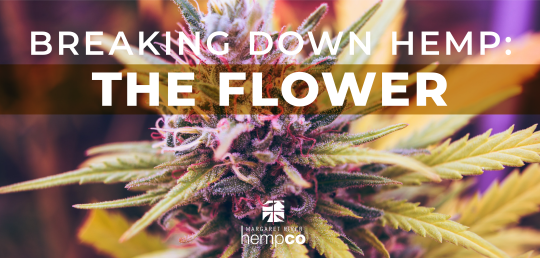
Often confused with the psychoactive variant of the Cannabis plant, hemp is not the same – and as such, has different uses. Despite looking and smelling alike, hemp flower produces different cannabinoid concentrations than what many know as ‘Marijuana’.
…So, what’s the difference?
Over time, people bred cannabis for different things. Sometimes, they would breed shorter, denser varieties to produce more seed per acre. Others, taller plants for more fiber. And as people started using it recreationally, they basically started breeding it for strength. As a result, we have the high-THC variation of cannabis Sativa known as ‘Marijuana’. But even more recently, people started utilising modern breeding practises to breed THC out of the plant.
Why? So the plant produces more CBD. CBD is medicine.
So now we have two classes of ‘cannabis Sativa’: Hemp and Marijuana. ‘Hemp’ is any plant grown for seed, fibre, or CBD hemp flower. ‘Marijuana’ is basically just a hemp flower that contains over 1% THC.
So now we’re past that, let’s take a deeper look at what hemp flower can be used for.
Where on the plant it is found
Hemp flowers are found on both the male and female hemp plants. However, on the female plant, they are elongated, spike-like clusters that produce seed when pollinated. On the male plants, the flowers are responsible for producing pollen, and form more clustered branches
The main flowers (also known as colas, tops, or heads) are found at the apex of the plant.
Does it contain THC?
Hemp flowers do contain THC. However, this concentration is low and contains high-CBD. THC, Tetrahydrocannabinol is the substance that produces the mind-altering effect of psychoactive strains of the cannabis plant.
Hemp must contain less than 1% THC in Australia. The law is set this way so that it is virtually impossible for users to experience the psychoactive effects no matter how much they consume. Research demonstrates that hemp contains more than 500 chemical compounds and though one of this is THC, its quantity is negligible.
So what can it be used for?
Hemp flowers are legal in most countries including the US, and the majority of EU countries. But in Australia, if you have a licence to grow Hemp, you are unable to use the flower or leaf. Flowers are very easy to grow and harvest, and can be done by hand or machine. The less mechanical processing, the more of the naturally occurring cannabinoids, terpenes, flavonoids, and other organic compounds remain intact in the plant – and that’s what you want for medicine.
Smoking hemp is the most used method of flower consumption, however, trends are moving towards more health conscious methods of consuming CBD. It has a relaxing effect without producing any “high”. It can come as pre-rolled CBD cigarettes. Smoking in itself is not a healthy habit, but CBD cigarettes seem to be helpful for people searching for alternatives to nicotine cigarettes and psychoactive breeds of cannabis.
Healthier options include using the flower in cooking or brewing as tea, although this method requires trial and dosing.
Hemp flowers will produce hemp seed if pollinated.
Hemp seeds are actually a type of fruit botanically. They belong to a group called an achene. They are formed from the pollinated hemp flowers, just as with any other type of true fruit. This means that a hemp farmer can choose from one of two paths each crop: seed or CBD (and that’s before even using the stalks, leafs, and roots!)
Hemp seed can be eaten whole, hulled /dehulled
Hemp seeds can be eaten with or without the shell. Whole means unhulled, that the seeds still have their shells. The ‘whole’ variants of hemp seed are crunchy, contain lots of fibre, and serve as a great source of minerals. They can be sprinkled on top of salads, yoghurt or sandwiches – and you can never have too much!
Hulled (dehulled) hemp seeds are hemp seeds with their shells removed. Also called hemp hearts and hemp nuts, they’re actually the only type of hemp seed available as food to us over here in Australia. Currently, it’s required that hemp seeds have their ‘hull’ (shell) removed in case they contain leftover cannabinoids from the plant they came from, though there are no cannabinoids in the seed itself, this only occurs if the seed has not been cleaned probably. Also, you may grow a plant in your back garden!!
Hemp seed can be ground up into different forms such as…
Flour
Hemp Flour is made from raw hemp seeds which are made up of about 30% oil. After the grinding process, the hemp oil is extracted. It is also known as hemp powder or bran. It is much cheaper than protein powder.
Protein
The production of hemp protein requires an abundance of healthy and ripe hemp seeds. Hemp seed oil is first extracted from the seeds by cold pressing and hemp cake is obtained as a by-product. The hemp cake is then sieved several times. If the cake is only “roughly” sown, it produces hemp flour, which is rich in dietary fibre, most of which is retained in the seed shells.
Further high granulation sieving removes larger particles of hemp seed shells which leaves much more protein-rich particles that are found inside the seeds (hemp hearts). Thus, hemp protein powder is obtained.
Nutritional benefits of hemp
Hemp as seed, flour, or protein is rich in gluten-free fibre which helps with digestion and can assist in the prevention of a number of health issues. Similarly, the seed oil is rich in heart-healthy oils including omega 3 and 6 fatty acids (the only plant source of this essential fatty acid).
Hemp Flower can be used for CBD oil if not pollinated
How is it turned into CBD oil
CBD is one of over 100 cannabinoids in the hemp plant. It accounts for 40% of any extract from the flower. There are different ways to extract it from the flower but the most popular and most accessible method is “Carrier oil solvent”.
It’s obviously a bit more complicated than this – and probably not legal to share the whole process. So, here’s the quick version.
After flowers are obtained, they are put into a container as small as a crockpot or as large as an industrial drum, along with a carrier oil – coconut oil, for example. The mixture is subjected to low heating. A perfect balance must be created between the temperature needed for extraction and not damaging the nutrients in the flower. The oil is stirred at regular intervals and “cooked” for nothing less than 3 hours.
The mixture is then strained, the new CBD oil is bottled and stored.
What are the benefits
Cannabidiol (CBD) is a popular natural remedy for a variety of mental and physical ailments From anxiety to PTSD, and pain management to epilepsy. It is used topically, orally, and even through suppositories in order to provide relief for a number of medical issues that at times, may not have been possible through traditional medicine.
So, why is CBD so effective? Because of the body’s endocannabinoid system.
CBD is also well known for its application in cancer management. It helps to reduce nausea and vomiting associated with cancer treatment. Research is also finding that it is neuroprotective and can be used in the treatment of epilepsy and multiple sclerosis.
And now we’ve been through that, let’s get back to the point.
Isn’t it incredible how many different things that just the flower of this simple plant can be used for?
Next week, we’re going to get to talking about the stalk.
#Hemp#flowers#agriculture#agribusiness#industrial hemp#economy#hempcommunity#ecofriendly#australian businesses#farming#farmlife#farmers#hempseedoil#hemp products#farmland#cannabis#cbd#hemp news#australien#farm living#healthcare#business#startups#companies#margaret river#HempCo
4 notes
·
View notes
Text
Explore the varieties of sesame seeds with this comprehensive guide. From white to black, hulled to unhulled, discover the various varieties of sesame seeds and their culinary uses.
0 notes
Text

#did you know that
For unhulled legumes, soaking is necessary, the water of which must be discarded.
The important thing is not to use bicarbonate (not even in Cecina or farinata) which not only alters the flavor but impoverishes the legumes, as it tends to alter their nutritional qualities (reduces the absorption of vitamins).
To reduce the waste resulting from their consumption, it is suggested to add a small piece of kombu seaweed during the soaking phase (the same can then also be used in the subsequent cooking phase).
This prevents the discomfort of stomach swelling as Kombu is a natural intestinal purifier, also useful for those suffering from intestinal fermentation.
📚 Healthy Food
#sapeviche
Per i legumi non decorticati è necessario ammollo, la cui acqua va eliminata.
L'importante è non utilizzare il bicarbonato (neppure nella Cecina o farinata) che non solo altera il sapore ma impoverisce i legumi, in quanto tende ad alterarne le qualità nutrizionali (riduce l’assorbimento di vitamine).
Per ridurre la faltulenza conseguente al loro consumo, si suggerisce di aggiungere un piccolo pezzetto di alga kombu in fase di ammollo (la stessa potrà essere poi utilizzata anche nella successiva fase di cottura). Questo previene il fastidio del gonfiore di pancia in quanto la Kombu è un depurativo naturale dell’intestino, utile anche a chi soffre di fermentazioni intestinali.
📚Il Cibo della Salute
0 notes
Text
Sesame seeds are a popular ingredient in many cuisines around the world, adding a nutty flavor and crunchy texture to dishes. However, not all sesame seeds are created equal. In this article, we will explore the differences between unhulled sesame seeds and regular sesame seeds, and which one is better for your health and cooking needs.
Unhulled sesame seeds, also known as black sesame seeds, are whole sesame seeds with their outer hulls intact. Regular sesame seeds, on the other hand, have had their hulls removed during processing. This difference in processing results in some notable differences between the two types of seeds.
Nutritional Value
One of the most significant differences between unhulled sesame seeds and regular sesame seeds is their nutritional value. Unhulled sesame seeds are generally considered to be more nutritious than regular sesame seeds due to their higher mineral content.
Unhulled sesame seeds contain higher levels of calcium, magnesium, iron, and zinc than regular sesame seeds. Calcium is essential for strong bones and teeth, while magnesium helps regulate blood sugar levels and promotes healthy bones. Iron is necessary for the production of red blood cells, and zinc is important for immune function and wound healing.
Additionally, unhulled sesame seeds contain more fiber than regular sesame seeds. Fiber is essential for digestive health and can help prevent constipation and promote feelings of fullness.
Flavor and Texture
Another difference between unhulled sesame seeds and regular sesame seeds is their flavor and texture. Unhulled sesame seeds have a stronger, nuttier flavor than regular sesame seeds due to the presence of the hulls. The hulls also give unhulled sesame seeds a slightly grittier texture than regular sesame seeds.
Regular sesame seeds, on the other hand, have a milder, sweeter flavor and a smoother texture due to the removal of the hulls. This makes them a popular choice for sweet dishes, such as baked goods and desserts.
Cooking Uses
The differences in flavor and texture between unhulled sesame seeds and regular sesame seeds also affect their cooking uses. Unhulled sesame seeds are often used in savory dishes, such as stir-fries, soups, and sauces, where their strong flavor and gritty texture add depth and texture to the dish.
Regular sesame seeds, on the other hand, are commonly used in sweet dishes, such as baked goods and desserts, where their mild flavor and smooth texture complement the sweetness of the dish. They are also commonly used as a garnish for dishes, such as salads and soups, where their crunchy texture adds a nice contrast to the softness of the other ingredients.
Health Benefits
Both unhulled sesame seeds and regular sesame seeds offer a range of health benefits. Sesame seeds are a good source of protein, healthy fats, and vitamins and minerals.
Unhulled sesame seeds, due to their higher mineral content, may offer additional health benefits. Studies have shown that the high magnesium content in unhulled sesame seeds may help lower blood pressure and reduce the risk of heart disease. The high calcium content may also help promote bone health.
However, it's important to note that the hulls of unhulled sesame seeds can be difficult to digest, especially for people with digestive issues. This can lead to bloating and discomfort. Regular sesame seeds, on the other hand, are generally easier to digest due to the removal of the hulls.
Both unhulled sesame seeds and regular sesame seeds offer unique benefits and uses in cooking and nutrition. Unhulled sesame seeds are more nutritious due to their higher mineral content, but they have a stronger flavor and grittier texture. Regular sesame seeds have a milder flavor and smoother texture, making them a popular choice for sweet dishes and garnishes.
Ultimately, the choice between unhulled sesame seeds and regular sesame seeds comes down to personal preference and cooking needs. If you prefer a stronger flavor and are looking for a more nutritious option, unhulled sesame seeds may be the way to go. If you prefer a milder flavor and are using sesame seeds as a garnish or in sweet dishes, regular sesame seeds may be the better choice.
0 notes
Text
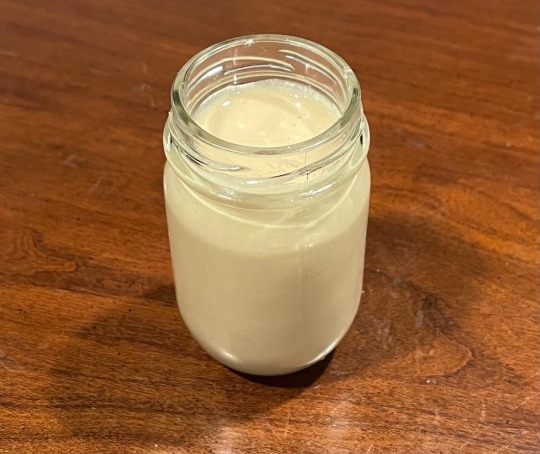
[ID: A small jar filled with a light beige dip. End ID]
طحينة / Tahina: Toasted sesame dip
"طَحِينَة" ("ṭaḥīna") is an Arabic word formed from the root ط ح ن (ṭ ḥ n), which produces words relating to grinding; compare "طَحَنَ" ("ṭaḥana"), “to grind,” and "طَحِين" ("ṭaḥīn"), "flour." In English, the word is often spelled and pronounced "tahini" due to the influence of a colloquial Levantine pronunciation. Tahina may also be called "رهش" ("rahash"), "راشي") ("rashi"), or "هردة" ("harada").
This paste is produced by steaming, hulling, and then stone milling sesame seeds until they release their oil, resulting in a smooth, pourable texture. It may be called "طَحِينَة بَيْضَاء" ("ṭaḥīna bayḍā'"), "white tahina," to differentiate it from darker-colored tahinas that are produced by toasting sesame seeds before they are ground, or from grinding unhulled sesame seeds; but "tahina" without further specification is taken to mean "white tahina."
Tahina may be eaten on its own as a dip or sauce; it also forms the primary ingredient in طراطور (tarator), a tahina sauce with lemon juice and garlic. Tahina adds deep, nutty flavor to hummus, baba ghannouj, and halwa.
Recipes for homemade tahina call for some amount of oil to be added to ground sesame seeds, since most homes are not set up to do hours of stone milling. This means that homemade tahina is, in my opinion, likely an inferior product to something you can buy at the store. However, sometimes you have emergency tahina needs.
This recipe provides instructions for taking sesame seeds as far towards a pourable texture as possible without additional oil, using a mortar and pestle to imitate the traditional stone grinding; it also gives instructions for using an electric mill or blender.
Recipe under the cut!
Patreon | Tip jar
Equipment:
A spice mill or coffee grinder
OR a high-speed blender
OR a high-quality, well-seasoned, solid stone or metal mortar and pestle
Ingredients:
1/4 cup hulled sesame seeds
2 Tbsp - 1/4 cup sesame oil (untoasted), as necessary
Instructions:
1. Toast sesame seeds, agitating frequently, in a single layer in a dry skillet over medium-low heat. Remove when lightly golden brown.
Some home cooks toast half of the sesame seeds and leave the other half untoasted.
2. With a mortar and pestle: Thoroughly scrub and oil a large mortar and pestle. Add seeds in small batches and process, alternating between pounding and grinding, until a fluffy, powdered texture results.
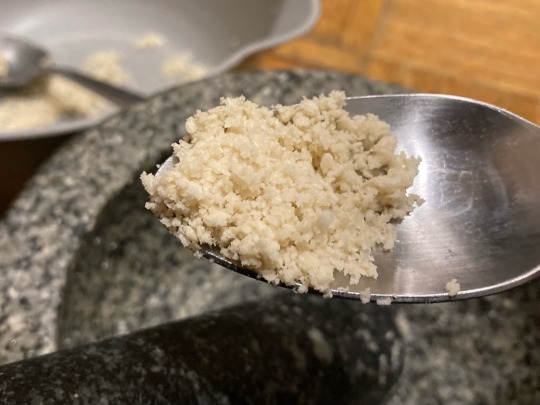
Continue, alternating between pounding the powder all together in the middle of the mortar, and spreading it into a thin layer along the sides of the mortar and scraping, until it begins to resemble a paste. You will start to see oil shimmer at the surface.
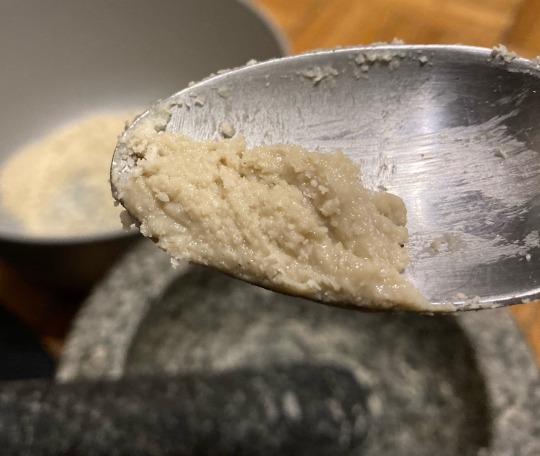
Keep pounding and scraping, in batches of about 1 Tbsp at a time, until the tahina looks smooth and shiny, and you no longer see noticeable lumps in it. Repeat until all the seeds have been ground.
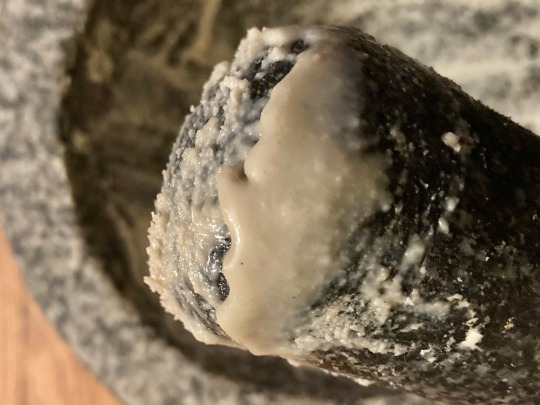
Combine all the paste into one bowl. Slowly, and while stirring, add just enough sesame oil as required to obtain a pourable texture.
This batch took me about four hours of hand-grinding and yielded about 3 Tbsp of tahina (I didn't say this was a good idea).
2. With a spice or coffee grinder: Allow toasted seeds to cool and then grind them, occasionally shaking the grinder, until very fine. Remove into a bowl and mix in oil.
2. With a blender: grind sesame seeds and oil together for several minutes until very smooth. You will likely need to make a larger batch, depending on the size of your blender.
3. Use immediately, or store in an airtight container in the fridge.
80 notes
·
View notes
Text
Beer Events 10.29
Events
Charles Haley patented California Pop Beer (1872)
Austin Connelly patented an Improvement in Faucets and Bushings (1878)
Fire destroyed the Diamond State Brewery, a.k.a. Johanna S. Stoeckle (Delaware; 1881)
Henry Shlaudeman patented a Refrigerator Building for Fermenting and Storing Beer (1881)
Frederick Hinckel Sr. died (1881)
Black Tuesday, the Wall Street Stock Market Crash (1929)
Blatz Brewing 1st released their beer in cans (1935)
Fitger Brewing 1st released their beer in cans (1935)
Albert Tomson patented a Beer Cooler (1941)
William McMillan and Leonard Smith patented a Draft Beer Metering Apparatus (1968)
Internet created (1969)
Dongguk University Industry-Academic Cooperation Foundation patented a Method for Production of Beer Using Unhulled Rice and Rice Beer Thereof (2009)
Breweries Opened
Geelong Brewing (Australia; 1989)
Copperhead Brewing (Canada; 1992)
Alcatraz Brewing (Indiana; 1995)
0 notes
Text
Discover the key differences between hulled and unhulled sesame seeds and their impact on the export market for spices. Uncover the essential aspects to consider when exporting these sought-after seeds, and learn which variety holds the competitive advantage in the spice industry. Delve into the flavors, uses, and demand for these sesame seed types, as we explore the global implications of their exportation in the spice trade.
1 note
·
View note